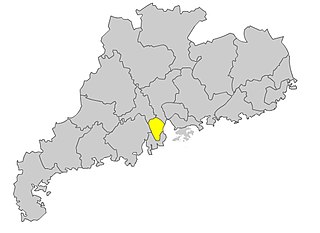| Longdu dialect | |
|---|---|
| 隆都話 | |
| Native to | China |
| Region | Dachong and Shaxi, Guangdong, Hawaii, US-Canada Chinatowns |
Sino-Tibetan
| |
Early forms | |
| Language codes | |
| ISO 639-3 | (zld is proposed
[4]) |
| Glottolog |
long1252 |
 Location of Zhongshan 中山 within Guangdong 广东 Province, China | |
The Longdu dialect is a variety of the Eastern Min branch of Chinese originating from the towns of Dachong and Shaxi in Zhongshan in the Pearl River Delta of Guangdong. [5] The two regions Shaxi and Dachong are together informally known as the Longdu region to locals and those overseas. There are more than 40 villages in the region and are held together by their shared dialect, which may be classified as endangered due to its deterioration in status and rapidly decreasing popularity even within the Longdu region. Despite its close proximity, the Longdu dialect is not very closely related to the surrounding dialects in the region, which belong to the Yue group. As such, Longdu forms a "dialect island" of Min speakers. It is one of three enclaves of Min in Zhongshan, the others being Sanxiang and Nanlang. [6]
According to Søren Egerod, who published an extensive study of the dialect based on fieldwork conducted in 1949, the vocabulary consists of three layers:
- a pre- Tang colloquial layer, which seems to be related to the Fuzhou dialect,
- a Tang-period colloquial layer, which seems to be related to various Southern Min varieties, and
- a layer of literary readings based on the Shiqi dialect, the local Yue variety. [7]
The Longdu dialect is a mother tongue of many overseas Chinese. Its native speakers generally understand Cantonese, but not vice versa. According to the Language Documentation Training Center at the University of Hawaiʻi at Mānoa: "A lot of children do not speak the language in their daily lives. The population of speakers is diminishing." [8] It is slowly disappearing due to the emigration of people from the Longdu region to other countries, and due to the lack of inter-generational knowledge sharing. At school, only Mandarin is taught to children due to its status as the official national language, whereas in the home, parents and grandparents teach the children only Cantonese, given that the Longdu region is within Zhongshan, Guangdong, and that Cantonese is generally viewed as the lingua franca of Guangdong.
See also
Notes
References
- ^ Mei, Tsu-lin (1970), "Tones and prosody in Middle Chinese and the origin of the rising tone", Harvard Journal of Asiatic Studies, 30: 86–110, doi: 10.2307/2718766, JSTOR 2718766
- ^ Pulleyblank, Edwin G. (1984), Middle Chinese: A study in Historical Phonology, Vancouver: University of British Columbia Press, p. 3, ISBN 978-0-7748-0192-8
- ^ Hammarström, Harald; Forkel, Robert; Haspelmath, Martin; Bank, Sebastian (2023-07-10). "Glottolog 4.8 - Min". Glottolog. Leipzig: Max Planck Institute for Evolutionary Anthropology. doi: 10.5281/zenodo.7398962. Archived from the original on 2023-10-13. Retrieved 2023-10-13.
- ^ "Change Request Documentation: 2021-045". 31 August 2021. Retrieved 30 May 2022.
- ^ "Longdu (Jiamin) - About Longdu".
- ^ Bodman, Nicholas C. (1985). "The Reflexes of Initial Nasals in Proto-Southern Min-Hingua". In Acson, Veneeta; Leed, Richard L. (eds.). For Gordon H. Fairbanks. Oceanic Linguistics Special Publications. Vol. 20. University of Hawaii Press. pp. 2–20. ISBN 978-0-8248-0992-8. JSTOR 20006706. pp. 5–6.
- ^ Egerod, Søren (1956). The Lungtu Dialect: A Descriptive and Historical Study of a South Chinese Idiom. E. Munksgaard. pp. 280–281.
- ^ "Longdu (Jiamin) - About Longdu".